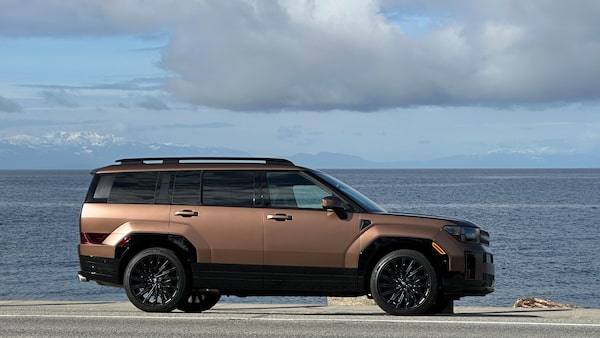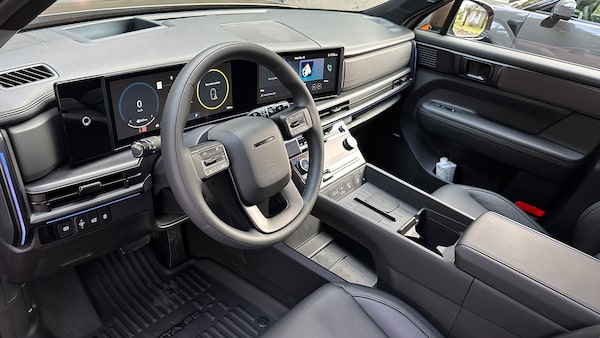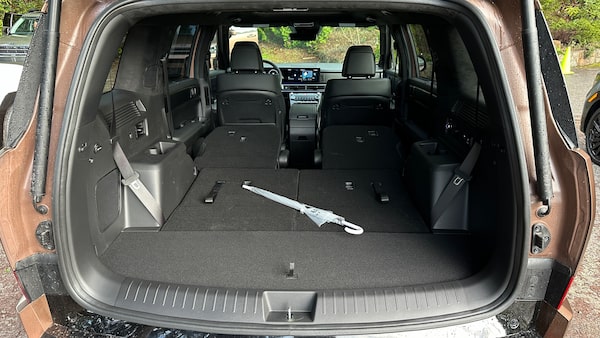
The 2024 Hyundai Santa Fe.Mark Richardson/The Globe and Mail
This is a review of Hyundai’s brand-new, fifth-generation Santa Fe, but the hybrid version was not available here in British Columbia for me to drive. That’s too bad – it’s less powerful than the gas-powered SUV, but it’s much better for fuel consumption and it’s more affordable, too. Normally, hybrids cost more, because they’re packing extra hardware for two drivetrains, but not with the new Santa Fe.
“In our research, we found that people who are more price sensitive, who don’t have the money to buy the top-trim Calligraphy model – they’re more concerned about fuel efficiency and operating costs,” says Michael Ricciuto, Hyundai Canada’s director of product and corporate strategy. “That drove our decision to put the lower operating cost powertrain as the base powertrain. People who want the ruggedness and luxury features are typically looking for more power, which is why we left the more powerful engine in the top trims.”
And all this time, we’ve thought the technology behind hybrid engines was so costly that we’ve been paying a premium for them. This must be a turning point for electrification.
In any case, the latest generation of the Santa Fe is a turning point for the nameplate. It looks very different, for a start. When I first saw it, I thought it was an electric vehicle, but it’s just designed that way. There are no plans to electrify the Santa Fe beyond offering a hybrid engine, because Hyundai’s Ioniq models are already the brand’s EVs. There is a plug-in hybrid version of the new Santa Fe that’s sold in Europe, but it won’t be offered here.
The new generation is longer and taller by 45 and 35 millimetres respectively, and that gives it a definite feeling of spaciousness inside. It also gives it an extra 120 litres of luggage capacity, which is helped considerably by having much wider access at the rear. The struts for the cargo door are moved to the outside of the storage area and the opening itself is more than 14 centimetres wider than the previous generation, although the width of the vehicle is no different.
The new generation is longer and taller than the previous one.Mark Richardson/The Globe and Mail
There’s only one conventional gasoline engine available, which is a 2.5-litre turbocharged four-cylinder that’s good for 277 horsepower. Compare that to the base models of the outgoing SUV, which made 191 horsepower. That older generation offered a 281-horsepower turbo edition in the higher trims that made identical torque – 311 lb-ft – so it’s essentially the same. The previous generation was about a couple of thousand dollars cheaper, too, at each trim level except the hybrid.
The new hybrid will be the more interesting comparison. It’s more powerful than before, with 231 horsepower compared to the old hybrid at 178 horsepower, but the much greater 271 lb-ft of torque is found at just 1,000 revolutions per minute, compared to the 195 lb-ft at 4,500 of the outgoing hybrid. When we drive that new car in a few months’ time, we’ll let you know what we think.
Tech specs
2024 Hyundai Santa Fe
- Base price/as tested: $42,999 / $55,499, including freight and predelivery inspection, plus fees and taxes
- Engine: 1.6-litre turbo four-cylinder hybrid; 2.5-litre turbo four-cylinder
- Horsepower/Torque (lb-ft): 231 / 271 (hybrid); 277 / 311
- Transmission/Drive: Six-speed automatic / all-wheel drive (hybrid); Eight-speed automatic / all-wheel drive
- Fuel consumption (litres per 100 kilometres): 6.8 city, 6.9 highway, 6.9 combined (hybrid); 12.1 city, 8.8 highway, 10.6 combined
- Alternatives: Kia Sorento, Honda Passport, Toyota Highlander, Nissan Murano, Volkswagen Atlas
Looks
Hyundai says it wasn’t sure how people would like the looks of the new Santa Fe, after four generations of smooth and traditional rounded-off lines. “It’s actually very slab-sided, so the tumblehome (the inward angle of the windows) is very upright and it doesn’t have the traditional, swoopy kind of look to it,” says Ricciuto. “It’s a really aggressive, two-box design. When you lose that swoopiness, it tends to look more blocky and we were concerned that the overall design cues on it were going to be polarizing.”
Whatever you think of it, though, the design is more aerodynamic than before, with a drag co-efficient of 0.294. That’s not great compared to a Tesla Model Y or a Lucid Gravity (both at 0.23), but it’s better than a Jeep Wrangler (0.45) and any improvement is a good thing.
Interior

The digital gauges are contained on two screens that sweep across the driver’s side of the cabin.Mark Richardson/The Globe and Mail
I drove both the top-of-the-line “Ultimate Calligraphy” and the mid-level XRT, which is the more rugged edition and the least costly of the gas-only models, and both were nicely fitted inside. The digital gauges are contained on two screens that sweep across the driver’s side of the cabin. They’re not enormous, but they are well integrated into the fascia so they don’t overwhelm with information, like some vehicles.
The Calligraphy has a pair of captain’s chairs for its second row, compared to a bench for the other editions, so it seats six people instead of seven. The third row is cramped in that the seats are low to the floor, which makes them better for kids. There’s plenty of leg and headroom in the second row and it’s a comfortable ride back there, though I didn’t last long on the winding road of the Sunshine Coast before I needed a Gravol.
Performance
I didn’t notice much difference in the driving between the old and the new Santa Fe and the statistics above bear that out. It has plenty of power for what you need. Fuel economy has suffered, though. Compare this engine’s rating of 12.1 city, 8.8 highway and 10.6 combined with the older generation’s 11, 8.5, and 9.9. I saw a combined average of 11.4. The claimed figures for the hybrid are improved across the board, at least.
Technology
Your smartphone will lay flat on a slightly raised, non-slip pad, which means the tiny extension of the camera lens won’t raise it from the tray.Mark Richardson/The Globe and Mail
You name it, it’s probably available, but the real question is what is offered as standard without paying extra. Adaptive cruise control, blind spot collision warning, automatic high beam assistance, lane-keep assistance and forward collision avoidance assistance are all standard for all models, which would have been unheard of five years ago.
A shout-out here to whoever designed the wireless charging tray. Your smartphone will lay flat on a slightly raised, non-slip pad, which means the tiny extension of the camera lens won’t raise it from the tray. It’s easy and, unlike a pair of Toyotas I drove recently, it will charge every time with no fuss and no break in connection.
Cargo

The opening for the trunk is more than 14 centimetres wider than the previous generation, although the width of the vehicle is no different.Mark Richardson/The Globe and Mail
There’s more space in the back and both rows of seats really do fold flat. The extra width of the rear door also makes loading easier. There’s no standard spare wheel – it can be bought as an option – but this means the floor is lower for easier access.
The verdict
The new Santa Fe is capable and satisfying and offers a great deal for the money. The real question is how its gas-only models will compare to the hybrid, which will be released this summer and is a greater departure under the hood.
The writer was a guest of the automaker. Content was not subject to approval.
Shopping for a new car? Check out the new Globe Drive Build and Price Tool to see the latest discounts, rebates and rates on new cars, trucks and SUVs. Click here to get your price.
 Mark Richardson
Mark Richardson